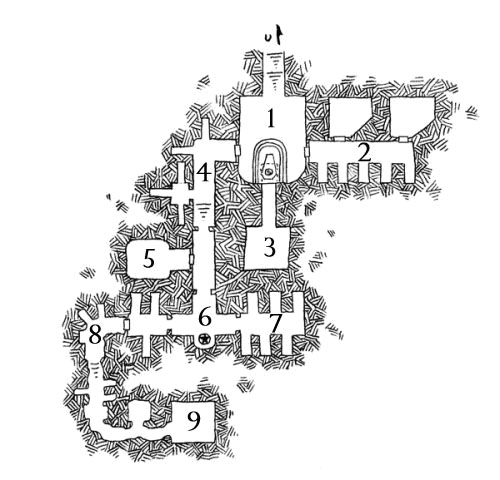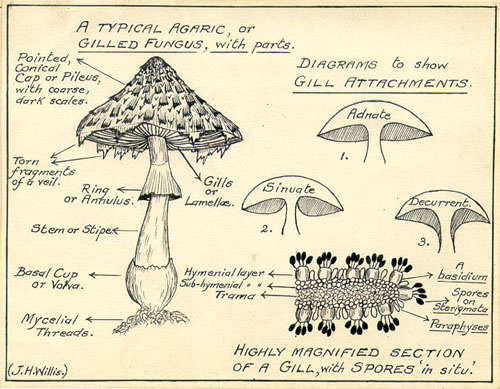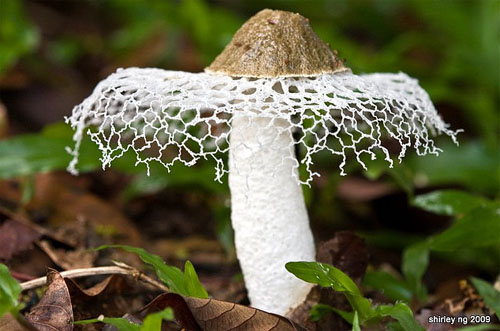Go to Part 1
When designing my hexcrawl, as I mentioned at the beginning of this series, I key every hex on the map and every key entry is a location (not an encounter). The distinction between a “location” and an “encounter” can get a little hazy if you stare at it for too long, but in practice it’s usually pretty obvious: If your key reads “an ogre walking down the road”, then the next time the PCs pass along that road the ogre would presumably be gone (particularly if they killed it). If your key instead reads “an ogre living in a shack”, then even if the PCs kill the ogre the shack will still be there.
Of course, one might argue that the PCs could do some quick demolition work on the shack and make it disappear, too. (That would be an excellent example of staring at the distinction for too long.) But the general point remains: You’re looking to key permanent geography, not ephemeral events.
What follows are several examples from the actual hex key I use for my Thracian Hexcrawl. The goal is to demonstrate the range of different key types that I use, so let’s start with the shortest:
K16 – HONEYCOMB CAVERNS (Secrets of Xen’dik)
No detail.
This one’s pretty simple: I’ve grabbed a pre-existing adventure (in this case selected from the Secrets of Xen’drik sourcebook) and plugged it straight into the hexcrawl. If the PCs encounter this hex, I just yank the book out and start running it.
I’ve actually been doing less of this recently because I’ve reached the point where I find the existing layout and presentation of adventure modules too frustrating to run on-the-fly even when the actual content is good. (They tend to bury way too much information into the middle of lengthy paragraphs.) But I digress. Here’s another simple one:
K13 – RUINED TEMPLE OF ILLHAN
See hex detail.
In this case, the location was too detailed to include in my primary hex key. Much like the published adventure, I’m telling myself to go look somewhere else for the details: In this case, a separate file folder in which I keep separate documents for each hex like this. (The rule of thumb here is that if it takes more than one page to describe the place, it gets a separate detail document.)
The details for the Ruined Temple of Illhan were previously posted here on the site. They can be found here. (The presentation there is somewhat polished from what would have been found in my original notes, but is substantially similar.)
A3 – ORLUK TOTEM
A giant statue, worn by weather. Depicting an elephantine beast of prey with black- and yellow-striped fur. (An orluk.) The yellow and black stone is not painted, but rather two different types of colored granite which have been quarried and then shaped to take advantage of the quarried strata.
This is an example of what I think of as a “landmark”. Sometimes these landmarks are more involved or have hidden features to them, but generally they’re just single points of interest distinct from the surrounding wilderness. Regardless of their other characteristics, they’re almost always useful for PCs trying to orient their maps.
N15 – RECENT FOREST FIRE
Landscape is scorched. No foraging is possible in this hex.
Another short one. This is basically similar to a landmark, but it covers a vast swath of territory. (In this case, an entire hex.)
C2 – WYVERN SHAFT
60 foot deep shaft that serves as the lair of a wyvern. The wyvern has dug an escape tunnel that emerges from a hill a quarter mile away.
WYVERN: Has a large scar on its left side from a spear wound; has preferred to stay away from intelligent prey ever since.
TREASURE: 7,000 sp, 5 zircons (50 gp each)
A simple monster lair. I usually don’t bother with maps for this sort of thing: It’s easy enough to improv any smaller complex of a half dozens rooms or less. (Assuming there’s nothing radically unusual about them, of course.)
F15 – SKULL ROCK (on river)

A rock shaped like a skull thrusts out of the river. Crawling through the mouth leads to a crypt.
AREA 1: Mummified red dragon’s head (huge). Breathes flame that fills most of the room. Secret entrance to treasure chamber under the head.
AREA 2: 5 wights (50% in lair), no level drain but paralyzing strike. The two rooms off this area have been pillaged.
AREA 3 – BURIAL OFFERINGS: 3000 gp, 3 golden spinels (200 gp each)
AREA 4: Trapped hallway. Arrows shoot from wall and alchemist’s fire from nozzles in the ceiling. (Room to the left has an incense burner in the shape of a squat, fat man worth 7000 cp.)
AREA 5: Wight, no level drain but can detect magic, life, and invisibility at will. (Sniffs out magic and lusts for it.)
AREA 6: Bas relief skull. Insane. Asks incredibly bad riddles (“What flies in the air?” “A bird.”), but then blasts those who answer with 1d6 magic missiles regardless.
AREA 7: Slain wights.
AREA 8: Staked vampires.
AREA 9: A lich has been chained to the wall. Arcs of purple electricity spark off him in eternal torment.
Notice the “on river” designator next to the key title. That indicates that the location is on the river flowing through this hex on the map: If the PCs are following the river, they’ll automatically encounter this location.
The map here was taken from Dyson Logos’ website. His site proved invaluable for stocking my hexcrawl, and there are a lot of other bloggers offering free maps out there.
This sort of fully-keyed, “mini-dungeon” represents pretty much the upper limit of what I’ll handle in a key entry before bumping it into a separate document.
Go to Part 9: The Four Documents of the Hexcrawl
















